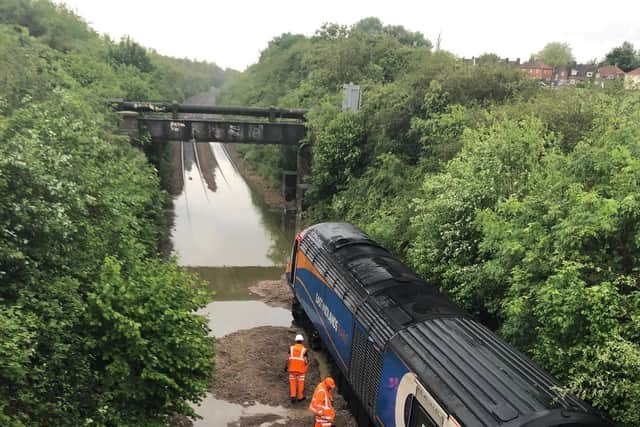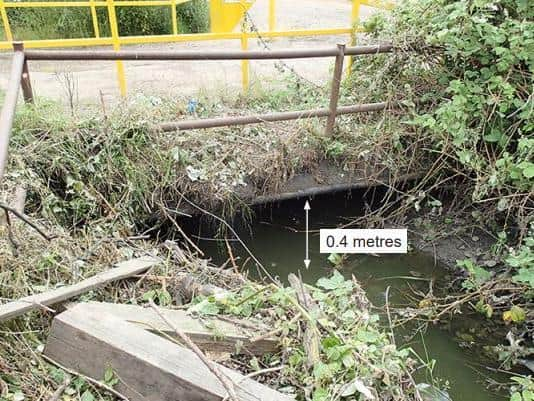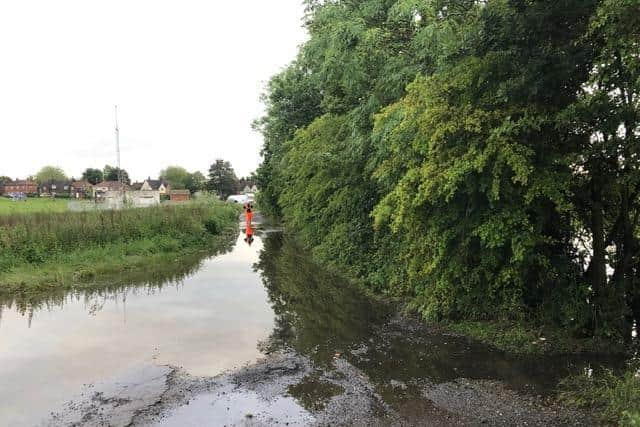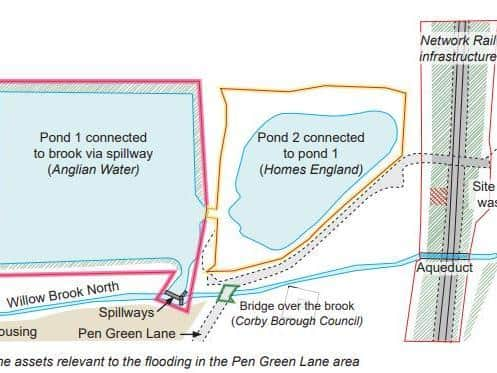Authorities at fault for landslip that trapped up to 550 passengers on Corby rail line
and live on Freeview channel 276
A lack of maintenance around the area of the Pen Green balancing ponds caused a railway line to flood, trapping up to 550 passengers from two trains in Corby for more than seven hours.
A critical report into last June's incident, released today (Tuesday, May 26) by the Rail Accident Investigation Branch, says that authorities including Corby Council, Northants County Council, Anglian Water, Network Rail and the Environment Agency failed to work together to maintain the flood management system in the area.
Advertisement
Hide AdAdvertisement
Hide AdThe situation is laid bare in six decades of correspondence that that show a sometimes 'adversarial' relationship between some of those organisations.


Today Network Rail said sorry for its part in the incident, and said it had taken the incident 'extremely seriously'.
Just before the incident, overspill from the bursting balancing ponds was prevented from flowing out to the Willow Brook because of debris blocking its route under a pedestrian bridge. This caused water to pool in a neighbouring field then plummet down the railway embankment, taking debris from the cutting with it, and on to the track. The debris then collided with a northbound train and trapped it. Flood water toward then stranded a southbound train at the same spot a few minutes later
The report says that the driver of the northbound London St Pancras to Nottingham train collided with the debris on the track at about 3.53pm on Thursday, June 13, 2019.
Advertisement
Hide AdAdvertisement
Hide AdAll 191 passengers on the train were taken on to a southbound train, also carrying passengers, which itself had stopped at a nearby spot at 4.15pm because of flood water.


Between 450 and 550 passengers from both trains were forced to endure cramped and warm conditions until 11.14pm when they were finally taken to nearby stations to continue their journey home. At the time, many passengers spoke to Northants Telegraph reporters to tell them of the poor conditions on board the second train.
The report details a 'significant delay' between the passengers becoming stranded and being able to get on buses to take them home because of a lack of equipment to safely move them.
It says: "While Network Rail was making arrangements, the drivers, traincrew and passengers on the train were not given any information about what was happening.
Advertisement
Hide AdAdvertisement
Hide Ad"During this time conditions on the train were uncomfortable and deteriorating. East Midlands Trains control noted that the train’s lights and toilet systems were still functioning, but the air conditioning was struggling to cool the coaches and it was becoming very hot on board.


"The catering car had also run out of drinks. Some of the passengers became agitated while waiting and threatened to detrain themselves.
"Consequently, the British Transport Police declared a major incident which activated the local fire and rescue service and ambulance service to attend.
"The ambulance service treated one person on the train who had fainted, and the fire and rescue service assisted with getting the passengers down from the train and off the railway."
Advertisement
Hide AdAdvertisement
Hide AdThe report describes a complicated ownership of different parts of the scene - with one balancing pond owned by Homes England, a second by Anglian Water, a footbridge by Corby Council and an aqueduct carrying water away from the ponds over the rail line owned by Network Rail. Northants County Council is the flood authority for the area, and the Environment Agency has responsibility for managing the water courses.


There had been heavy rainfall for five days before the incident and a member of Network Rail staff checked their trash gate on the aqueduct twice that day. An automatic alarm set up to send a text when the aqueduct reached 75 per cent capacity was avitvated - but nobody in the rail control room was set up to receive its text messages.
After the trains became stuck, Network Rail staff found a large amount of debris had collected under the Corby Council-owned pedestrian footbridge, stopping the water flowing from the ponds into the brook. When they released the debris, the water level began to drop.
By 7.30pm the second train, now carrying all the passengers, started to move northwards into the Corby Tunnel but the driver again encountered flood water so returned back down the track, arriving back at 8.25pm.
Advertisement
Hide AdAdvertisement
Hide AdAt 8.53pm, British Transport Police declared a major incident and all passengers were evacuated on to the track and then to waiting buses.
The report says that there had been repeated flooding at Pen Green since 1968. Correspondence between Britsh Rail and Corby Urban District Council shows flooding through the 1960s and 70s, resulting in the construction of the first balancing lake in 1976. The second was built in the 1990s to cater for the extensive development on the Earlstrees Industrial Estate.
The report says: "Copies of correspondence between British Rail (and later Railtrack), Corby Urban District Council (later Corby Borough Council) and the steelworks’ owners, dating from the 1960s through to the early 2000s, indicate that previous engagement between the involved parties was often adversarial, seeking to apportion blame and recover costs."


The report continues: "In June 2016, the railway flooded again and the cutting slope was washed- out in places. Network Rail reported that the flood water was coming over the crest of the cutting slope and washing debris onto the track. In May 2017, when the cutting slope was examined.., the examiner saw evidence of previous washouts, and so he noted the cutting slope as being at a high risk of washout.
Advertisement
Hide AdAdvertisement
Hide Ad"In April 2019, Network Rail devised a scope of work to repair the cutting slope and planned to carry this work out within 16 weeks. The incident occurred before this work had taken place."
Despite the serious risk of water flowing down the cutting, investigators found that no short-term mitigation had been put in place to manage the risk.
A second balancing lake at Pen Green is maintained by Anglian Water. Their automatic pumping system was put out of use several years ago because of repeated vandalism so had to be manually operated by a worker. The pump can lower water levels in the pond by releasing water into the Willow Brook. Despite heavy rainfall, no water had been pumped out of the ponds for more than one month before the incident.
The report says: "For the flood management system to function and be effective, it needed all of these organisations to work together rather than in isolation. As a result, the long- standing problem of flooding to the railway in the vicinity of Pen Green Lane was not addressed in a holistic way."
Advertisement
Hide AdAdvertisement
Hide AdGary Walsh, Route Director for Network Rail’s East Midlands Route, said: “Safety is our top priority and we take safety incidents, such as the landslip near Corby which occurred last year, extremely seriously.
“We’re very sorry for the experience which those passengers had and we have worked closely with the Rail Accident Investigation Branch on their report. We acknowledge the recommendations made and we have already begun to implement some of the recommendations.
“We have also carried out an internal investigation into this incident and taken measures, such as completing repairs to the cutting slope, to help to prevent an incident like this happening again.
“Huge strides have been made in railway safety over recent years. Britain now enjoys an enviable safety record that is second to none across Europe, but that record has been hard won through focus and action. This incident is a reminder that we cannot afford to be complacent and we will continue to work closely with the Rail Accident Investigation Branch and industry colleagues.”
Advertisement
Hide AdAdvertisement
Hide AdA spokesperson for Homes England said: “Since the incident last June, we have cooperated fully with the Rail Accident Investigation Branch’s investigation and accept the findings of the report.
“We have subsequently taken steps which include commissioning a scope of works to improve the operation and maintenance of the pond, and are fully committed to working with partners to ensure a more effective flood management system.”
A Corby Council spokeswoman said: "Corby Borough Council intends to continue to work with all relevant parties to ensure such an incident is avoided in the future.”
Cllr Jason Smithers, at Northamptonshire County Council, said: “Shortly after the incident occurred, we met with representatives at the Environment Agency, Anglian Water, Homes England, Corby Borough Council and Network Rail to determine how to move forward.
Advertisement
Hide AdAdvertisement
Hide Ad“Since then, we have been working closely as partners, to reduce the likelihood of incidents like this happening again.
“At NCC specifically, we have been supporting Network Rail with modelling and mapping the area to better understand the flood risk.
“Our priority has been to work together to implement an effective flood management system at this location, thereby mitigating any future flood risk and ensuring the safety of the area going forward.”
An Anglian Water spokesperson said: “We are usually able to maintain water levels in our balancing pond in Corby by pumping an excess water into a nearby stream. Last August, we were unable to do this because of heavy rainfall causing high water levels in the stream, which was also blocked by a fly tipped mattress. Had we pumped water from the balancing pond to the stream, there would have been a significant risk of flooding to the local area.
Advertisement
Hide AdAdvertisement
Hide Ad“Since the incident occurred we have been working with all the relevant agencies to help prevent any similar incidents in the future. Although the site is currently manually monitored due to previous vandalism of our pumping equipment, we are currently in the process of reinstalling automatic control of the pump so we can manage the water levels remotely.”
The report's authors make five recommendations:
1) The Environment Agency should, in conjunction with Northamptonshire County Council, Anglian Water, Homes England, Corby Borough Council and Network Rail, lead the production of a timebound plan to implement and maintain an effective flood management system at Pen Green Lane.
2) Network Rail should review its list of flood hotspots and work out a better system of communication with other organisations to try to reduce flooding.
3) Network Rail should review its processes for the management of earthworks, so that its staff responsible for earthworks have clear guidance on when and how to trigger appropriate monitoring and/or other short-term mitigations.
Advertisement
Hide AdAdvertisement
Hide Ad4) Network Rail should review its response to incidents where passengers are on stranded trains, as part of an ongoing piece of work with the Rail Delivery Group.
5) Network Rail should work with train companies to ensure the right equipment is in place to evacuate passengers and that staff are fully-trained in how to use it.
Comment Guidelines
National World encourages reader discussion on our stories. User feedback, insights and back-and-forth exchanges add a rich layer of context to reporting. Please review our Community Guidelines before commenting.